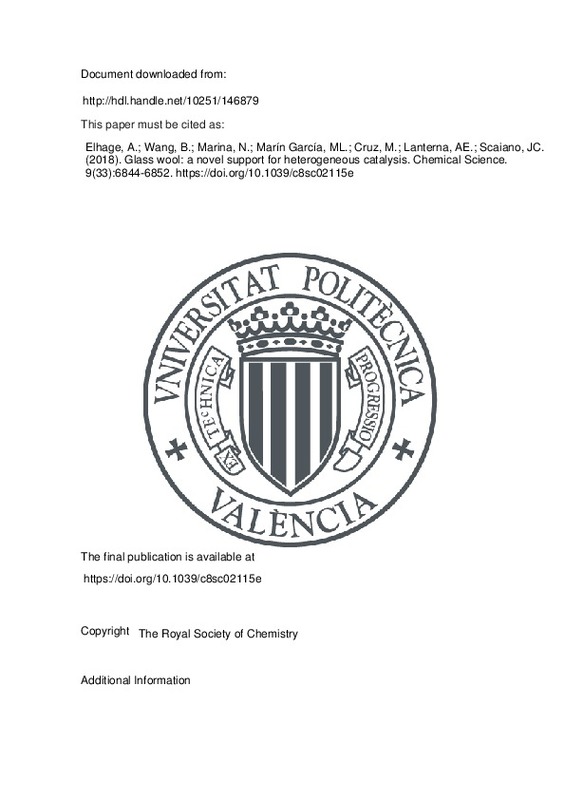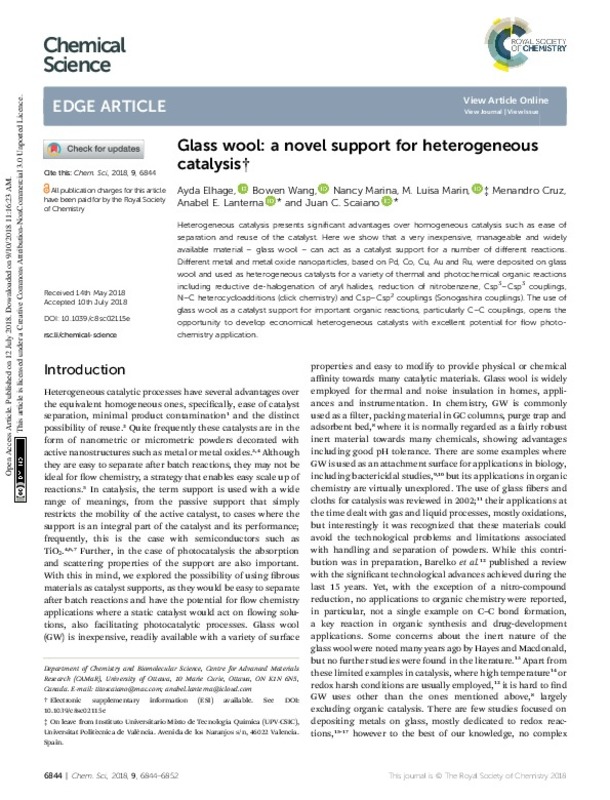JavaScript is disabled for your browser. Some features of this site may not work without it.
Buscar en RiuNet
Listar
Mi cuenta
Estadísticas
Ayuda RiuNet
Admin. UPV
Glass wool: a novel support for heterogeneous catalysis
Mostrar el registro sencillo del ítem
Ficheros en el ítem
| dc.contributor.author | Elhage, Ayda
|
es_ES |
| dc.contributor.author | Wang, Bowen
|
es_ES |
| dc.contributor.author | Marina, Nancy
|
es_ES |
| dc.contributor.author | Marín García, Mª Luisa
|
es_ES |
| dc.contributor.author | Cruz, Menandro
|
es_ES |
| dc.contributor.author | Lanterna, Anabel E.
|
es_ES |
| dc.contributor.author | Scaiano, Juan C.
|
es_ES |
| dc.date.accessioned | 2020-06-24T03:31:30Z | |
| dc.date.available | 2020-06-24T03:31:30Z | |
| dc.date.issued | 2018-09-07 | es_ES |
| dc.identifier.issn | 2041-6520 | es_ES |
| dc.identifier.uri | http://hdl.handle.net/10251/146879 | |
| dc.description.abstract | [EN] Heterogeneous catalysis presents significant advantages over homogeneous catalysis such as ease of separation and reuse of the catalyst. Here we show that a very inexpensive, manageable and widely available material - glass wool - can act as a catalyst support for a number of different reactions. Different metal and metal oxide nanoparticles, based on Pd, Co, Cu, Au and Ru, were deposited on glass wool and used as heterogeneous catalysts for a variety of thermal and photochemical organic reactions including reductive de-halogenation of aryl halides, reduction of nitrobenzene, Csp(3)-Csp(3) couplings, N-C heterocycloadditions (click chemistry) and Csp-Csp(2) couplings (Sonogashira couplings). The use of glass wool as a catalyst support for important organic reactions, particularly C-C couplings, opens the opportunity to develop economical heterogeneous catalysts with excellent potential for flow photo-chemistry application. | es_ES |
| dc.description.sponsorship | This work was supported by the Natural Sciences and Engineering Research Council of Canada, the Canada Foundation for Innovation, the Canada Research Chairs Program and funding from Canada's International Development Research Centre (IDRC). Thanks are due to the RISE program for the scholarship awarded to M. C. and the Generalitat Valenciana (BEST/2017/049) for the financial support granted to M. L. M. The authors would like to thank Dr Yun Liu for helping on the acquisition of the SEM images. | es_ES |
| dc.language | Inglés | es_ES |
| dc.publisher | The Royal Society of Chemistry | es_ES |
| dc.relation.ispartof | Chemical Science | es_ES |
| dc.rights | Reserva de todos los derechos | es_ES |
| dc.subject.classification | QUIMICA ORGANICA | es_ES |
| dc.title | Glass wool: a novel support for heterogeneous catalysis | es_ES |
| dc.type | Artículo | es_ES |
| dc.identifier.doi | 10.1039/c8sc02115e | es_ES |
| dc.relation.projectID | info:eu-repo/grantAgreement/GVA//BEST%2F2017%2F049/ | es_ES |
| dc.rights.accessRights | Abierto | es_ES |
| dc.contributor.affiliation | Universitat Politècnica de València. Departamento de Química - Departament de Química | es_ES |
| dc.description.bibliographicCitation | Elhage, A.; Wang, B.; Marina, N.; Marín García, ML.; Cruz, M.; Lanterna, AE.; Scaiano, JC. (2018). Glass wool: a novel support for heterogeneous catalysis. Chemical Science. 9(33):6844-6852. https://doi.org/10.1039/c8sc02115e | es_ES |
| dc.description.accrualMethod | S | es_ES |
| dc.relation.publisherversion | https://doi.org/10.1039/c8sc02115e | es_ES |
| dc.description.upvformatpinicio | 6844 | es_ES |
| dc.description.upvformatpfin | 6852 | es_ES |
| dc.type.version | info:eu-repo/semantics/publishedVersion | es_ES |
| dc.description.volume | 9 | es_ES |
| dc.description.issue | 33 | es_ES |
| dc.identifier.pmid | 30310617 | es_ES |
| dc.identifier.pmcid | PMC6114997 | es_ES |
| dc.relation.pasarela | S\379174 | es_ES |
| dc.contributor.funder | Canada Research Chairs | es_ES |
| dc.contributor.funder | Generalitat Valenciana | es_ES |
| dc.contributor.funder | Canada Foundation for Innovation | es_ES |
| dc.contributor.funder | International Development Research Centre, Canada | es_ES |
| dc.contributor.funder | Natural Sciences and Engineering Research Council of Canada | es_ES |
| dc.description.references | Davies, I. W., Matty, L., Hughes, D. L., & Reider, P. J. (2001). Are Heterogeneous Catalysts Precursors to Homogeneous Catalysts? Journal of the American Chemical Society, 123(41), 10139-10140. doi:10.1021/ja016877v | es_ES |
| dc.description.references | Conner, W. C., & Falconer, J. L. (1995). Spillover in Heterogeneous Catalysis. Chemical Reviews, 95(3), 759-788. doi:10.1021/cr00035a014 | es_ES |
| dc.description.references | Elhage, A., Lanterna, A. E., & Scaiano, J. C. (2016). Tunable Photocatalytic Activity of Palladium-Decorated TiO2: Non-Hydrogen-Mediated Hydrogenation or Isomerization of Benzyl-Substituted Alkenes. ACS Catalysis, 7(1), 250-255. doi:10.1021/acscatal.6b02832 | es_ES |
| dc.description.references | Cambié, D., Bottecchia, C., Straathof, N. J. W., Hessel, V., & Noël, T. (2016). Applications of Continuous-Flow Photochemistry in Organic Synthesis, Material Science, and Water Treatment. Chemical Reviews, 116(17), 10276-10341. doi:10.1021/acs.chemrev.5b00707 | es_ES |
| dc.description.references | Lanterna, A. E., Elhage, A., & Scaiano, J. C. (2015). Heterogeneous photocatalytic C–C coupling: mechanism of plasmon-mediated reductive dimerization of benzyl bromides by supported gold nanoparticles. Catalysis Science & Technology, 5(9), 4336-4340. doi:10.1039/c5cy00655d | es_ES |
| dc.description.references | Wang, B., Durantini, J., Nie, J., Lanterna, A. E., & Scaiano, J. C. (2016). Heterogeneous Photocatalytic Click Chemistry. Journal of the American Chemical Society, 138(40), 13127-13130. doi:10.1021/jacs.6b06922 | es_ES |
| dc.description.references | Sigma-Aldrich, Glass Wool, http://www.sigmaaldrich.com/catalog/product/supelco/20411?lang=en®ion=CA , accessed September, 2017, 2017 | es_ES |
| dc.description.references | Steyn, B., Oosthuizen, M. C., MacDonald, R., Theron, J., & Brözel, V. S. (2001). The use of glass wool as an attachment surface for studying phenotypic changes inPseudomonas aeruginosa biofilms by two-dimensional gel electrophoresis. PROTEOMICS, 1(7), 871-879. doi:10.1002/1615-9861(200107)1:7<871::aid-prot871>3.0.co;2-2 | es_ES |
| dc.description.references | Nisnevitch, M., Kolog-Gulco, M., Trombka, D., Green, B. ., & Firer, M. . (2000). Immobilization of antibodies onto glass wool. Journal of Chromatography B: Biomedical Sciences and Applications, 738(2), 217-223. doi:10.1016/s0378-4347(99)00514-9 | es_ES |
| dc.description.references | Matatov-Meytal, Y., & Sheintuch, M. (2002). Catalytic fibers and cloths. Applied Catalysis A: General, 231(1-2), 1-16. doi:10.1016/s0926-860x(01)00963-2 | es_ES |
| dc.description.references | Barelko, V. V., Kuznetsov, M. V., Dorokhov, V. G., & Parkin, I. (2017). Glass-fiber woven catalysts as alternative catalytic materials for various industries. A review. Russian Journal of Physical Chemistry B, 11(4), 606-617. doi:10.1134/s1990793117040030 | es_ES |
| dc.description.references | Macdonald, R. W., & Hayes, K. E. (1972). Glass wool as an oxidation catalyst. Journal of the Chemical Society, Chemical Communications, (18), 1030a. doi:10.1039/c3972001030a | es_ES |
| dc.description.references | Ramaswamy, G. K., Somasundaram, A., Kuppuswamy, B. K., & Velayudham, M. (2012). Glass Wool Catalysed Regioselective Isomerization of Styrene Oxides. Journal of the Chinese Chemical Society, 60(1), 97-102. doi:10.1002/jccs.201200269 | es_ES |
| dc.description.references | YANG, H., FANG, Z., FU, X., & TONG, L. (2007). A Novel Glass Fiber-Supported Platinum Catalyst for Self-healing Polymer Composites: Structure and Reactivity. Chinese Journal of Catalysis, 28(11), 947-952. doi:10.1016/s1872-2067(07)60081-3 | es_ES |
| dc.description.references | Bal’zhinimaev, B. S., Suknev, A. P., Gulyaeva, Y. K., & Kovalyov, E. V. (2015). Silicate fiberglass catalysts: From science to technology. Catalysis in Industry, 7(4), 267-274. doi:10.1134/s2070050415040029 | es_ES |
| dc.description.references | Simonova, L. G., Barelko, V. V., Toktarev, A. V., Chernyshov, A. F., Chumachenko, V. A., & Bal’zhinimaev, B. S. (2002). Kinetics and Catalysis, 43(1), 61-66. doi:10.1023/a:1014249129178 | es_ES |
| dc.description.references | Carrillo, A. I., Stamplecoskie, K. G., Marin, M. L., & Scaiano, J. C. (2014). ‘From the mole to the molecule’: ruthenium catalyzed nitroarene reduction studied with ‘bench’, high-throughput and single molecule fluorescence techniques. Catal. Sci. Technol., 4(7), 1989-1996. doi:10.1039/c4cy00018h | es_ES |
| dc.description.references | Morgan, D. J. (2015). Resolving ruthenium: XPS studies of common ruthenium materials. Surface and Interface Analysis, 47(11), 1072-1079. doi:10.1002/sia.5852 | es_ES |
| dc.description.references | Park, K. C., Jang, I. Y., Wongwiriyapan, W., Morimoto, S., Kim, Y. J., Jung, Y. C., … Endo, M. (2010). Carbon-supported Pt–Ru nanoparticles prepared in glyoxylate-reduction system promoting precursor–support interaction. Journal of Materials Chemistry, 20(25), 5345. doi:10.1039/b923153f | es_ES |
| dc.description.references | Bock, C., Paquet, C., Couillard, M., Botton, G. A., & MacDougall, B. R. (2004). Size-Selected Synthesis of PtRu Nano-Catalysts: Reaction and Size Control Mechanism. Journal of the American Chemical Society, 126(25), 8028-8037. doi:10.1021/ja0495819 | es_ES |
| dc.description.references | Espinós, J. P., Morales, J., Barranco, A., Caballero, A., Holgado, J. P., & González-Elipe, A. R. (2002). Interface Effects for Cu, CuO, and Cu2O Deposited on SiO2and ZrO2. XPS Determination of the Valence State of Copper in Cu/SiO2and Cu/ZrO2Catalysts. The Journal of Physical Chemistry B, 106(27), 6921-6929. doi:10.1021/jp014618m | es_ES |
| dc.description.references | Klyushin, A. Y., Rocha, T. C. R., Hävecker, M., Knop-Gericke, A., & Schlögl, R. (2014). A near ambient pressure XPS study of Au oxidation. Physical Chemistry Chemical Physics, 16(17), 7881. doi:10.1039/c4cp00308j | es_ES |
| dc.description.references | Higman, C. S., Lanterna, A. E., Marin, M. L., Scaiano, J. C., & Fogg, D. E. (2016). Catalyst Decomposition during Olefin Metathesis Yields Isomerization-Active Ruthenium Nanoparticles. ChemCatChem, 8(15), 2446-2449. doi:10.1002/cctc.201600738 | es_ES |
| dc.description.references | Bedford, R. B., Cazin, C. S. J., & Holder, D. (2004). The development of palladium catalysts for CC and Cheteroatom bond forming reactions of aryl chloride substrates. Coordination Chemistry Reviews, 248(21-24), 2283-2321. doi:10.1016/j.ccr.2004.06.012 | es_ES |
| dc.description.references | CRC Handbook of Chemistry and Physics , ed. D. R. Lide , Taylor and Francis Group , Boca Raton, FL , 88th edn, 2007 , p. 2640 | es_ES |
| dc.description.references | Sahoo, B., Surkus, A.-E., Pohl, M.-M., Radnik, J., Schneider, M., Bachmann, S., … Beller, M. (2017). A Biomass-Derived Non-Noble Cobalt Catalyst for Selective Hydrodehalogenation of Alkyl and (Hetero)Aryl Halides. Angewandte Chemie, 129(37), 11394-11399. doi:10.1002/ange.201702478 | es_ES |
| dc.description.references | Devery, J. J., Nguyen, J. D., Dai, C., & Stephenson, C. R. J. (2016). Light-Mediated Reductive Debromination of Unactivated Alkyl and Aryl Bromides. ACS Catalysis, 6(9), 5962-5967. doi:10.1021/acscatal.6b01914 | es_ES |
| dc.description.references | Liao, L., Zhang, Q., Su, Z., Zhao, Z., Wang, Y., Li, Y., … Bao, J. (2013). Efficient solar water-splitting using a nanocrystalline CoO photocatalyst. Nature Nanotechnology, 9(1), 69-73. doi:10.1038/nnano.2013.272 | es_ES |
| dc.description.references | Hainer, A. S., Hodgins, J. S., Sandre, V., Vallieres, M., Lanterna, A. E., & Scaiano, J. C. (2018). Photocatalytic Hydrogen Generation Using Metal-Decorated TiO2: Sacrificial Donors vs True Water Splitting. ACS Energy Letters, 3(3), 542-545. doi:10.1021/acsenergylett.8b00152 | es_ES |
| dc.description.references | Elhage, A., Lanterna, A. E., & Scaiano, J. C. (2018). Light-Induced Sonogashira C–C Coupling under Mild Conditions Using Supported Palladium Nanoparticles. ACS Sustainable Chemistry & Engineering, 6(2), 1717-1722. doi:10.1021/acssuschemeng.7b02992 | es_ES |
| dc.description.references | Roy, P., Periasamy, A. P., Liang, C.-T., & Chang, H.-T. (2013). Synthesis of Graphene-ZnO-Au Nanocomposites for Efficient Photocatalytic Reduction of Nitrobenzene. Environmental Science & Technology, 47(12), 6688-6695. doi:10.1021/es400422k | es_ES |
| dc.description.references | Zhou, B., Song, J., Zhou, H., Wu, L., Wu, T., Liu, Z., & Han, B. (2015). Light-driven integration of the reduction of nitrobenzene to aniline and the transformation of glycerol into valuable chemicals in water. RSC Advances, 5(46), 36347-36352. doi:10.1039/c5ra06354j | es_ES |
| dc.description.references | Zhu, H., Ke, X., Yang, X., Sarina, S., & Liu, H. (2010). Reduction of Nitroaromatic Compounds on Supported Gold Nanoparticles by Visible and Ultraviolet Light. Angewandte Chemie International Edition, 49(50), 9657-9661. doi:10.1002/anie.201003908 | es_ES |
| dc.description.references | Selvam, K., Sakamoto, H., Shiraishi, Y., & Hirai, T. (2015). Photocatalytic secondary amine synthesis from azobenzenes and alcohols on TiO2 loaded with Pd nanoparticles. New Journal of Chemistry, 39(4), 2856-2860. doi:10.1039/c5nj00158g | es_ES |
| dc.description.references | Sarina, S., Waclawik, E. R., & Zhu, H. (2013). Photocatalysis on supported gold and silver nanoparticles under ultraviolet and visible light irradiation. Green Chemistry, 15(7), 1814. doi:10.1039/c3gc40450a | es_ES |
| dc.description.references | Wang, L., Pan, X., Zhao, Y., Chen, Y., Zhang, W., Tu, Y., … Zhu, X. (2015). A Straightforward Protocol for the Highly Efficient Preparation of Main-Chain Azo Polymers Directly from Bisnitroaromatic Compounds by the Photocatalytic Process. Macromolecules, 48(5), 1289-1295. doi:10.1021/acs.macromol.5b00048 | es_ES |
| dc.description.references | Bandara, H. M. D., & Burdette, S. C. (2012). Photoisomerization in different classes of azobenzene. Chem. Soc. Rev., 41(5), 1809-1825. doi:10.1039/c1cs15179g | es_ES |
| dc.description.references | McGilvray, K. L., Decan, M. R., Wang, D., & Scaiano, J. C. (2006). Facile Photochemical Synthesis of Unprotected Aqueous Gold Nanoparticles. Journal of the American Chemical Society, 128(50), 15980-15981. doi:10.1021/ja066522h | es_ES |









